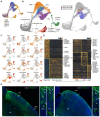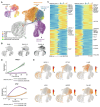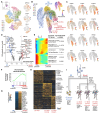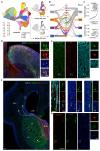Mouse and human share conserved transcriptional programs for interneuron development
- PMID: 34882453
- PMCID: PMC7618238
- DOI: 10.1126/science.abj6641
Mouse and human share conserved transcriptional programs for interneuron development
Abstract
Genetic variation confers susceptibility to neurodevelopmental disorders by affecting the development of specific cell types. Changes in cortical and striatal γ-aminobutyric acid–expressing (GABAergic) neurons are common in autism and schizophrenia. In this study, we used single-cell RNA sequencing to characterize the emergence of cell diversity in the human ganglionic eminences, the transitory structures of the human fetal brain where striatal and cortical GABAergic neurons are generated. We identified regional and temporal diversity among progenitor cells underlying the generation of a variety of projection neurons and interneurons. We found that these cells are specified within the human ganglionic eminences by transcriptional programs similar to those previously identified in rodents. Our findings reveal an evolutionarily conserved regulatory logic controlling the specification, migration, and differentiation of GABAergic neurons in the human telencephalon.
Conflict of interest statement
Figures






References
-
- DeFelipe J, Alonso-Nanclares L, Arellano JI. Microstructure of the neocortex: comparative aspects. J Neurocytol. 2002;31:299–316. - PubMed
Publication types
MeSH terms
Substances
LinkOut - more resources
Full Text Sources
Molecular Biology Databases

